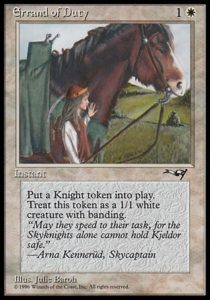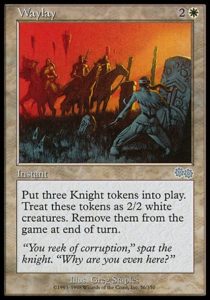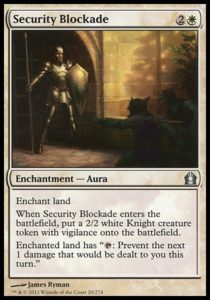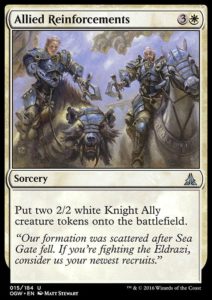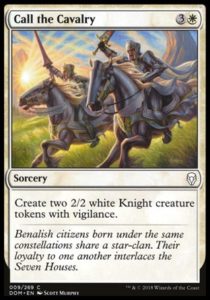Magic is an enormous game that constantly reinvents itself, threading the needle by innovating while remaining recognizably rooted to its past. Consequently, there are many cards that follow familiar forms, such as the Shock with set mechanic upside (like Galvanic Blast, Burst Lightning, Wild Slash, and Electrostatic Bolt); or a black spell granting -2/-2, often with some additional benefit. We may have recently seen the dawn of a new such trend in Gallant Cavalry. Today, let’s dive into the history of white knight tokens.
In the beginning, there was Errand of Duty, the very first card to create a Knight token. It successfully messed up defensive combat math, as all creatures with Banding do. Not exactly an auspicious start.
Several years later, there was Waylay, the first card to create 2/2 Knight tokens. In fact, it was also the last card to change the power & toughness of white knight tokens—since 1998, they’ve all been 2/2s. The only non-2/2 knight tokens since then were the black 1/1 vampire knight tokens created by Call the Bloodline and Sorin, Grim Nemesis.
Waylay played in the same vein as Tidal Wave, intending to be a defensive removal spell. Unfortunately, when the end of turn rules changed, it needed errata to not accidentally also be Ball Lightning. Neither Waylay nor Errand of Duty resemble the now-familiar “make two 2/2s” spells of today, but they are the humble origins of it.
After Errand of Duty and Waylay, there was nothing for a very long time. There were plenty of other tokens, but white usually made 1/1 soldiers and spirits, not 2/2 knights; black more often made 2/2s by creating copious amounts of zombies. Eventually, Scars of Mirrodin introduced of 2/2 cat tokens on a couple of rares, but we didn’t see 2/2 knights again until Return to Ravnica’s Knightly Valor finally introduced the 2/2 Knight token with Vigilance. Selesnya was big on tokens, so we saw more cards producing these tokens through the block.
In fact, the next card in RtR block to make 2/2 vigilant white knight tokens was Knight Watch, a card which is exactly Call the Cavalry, but one more mana expensive. At this point, we’ve found our clearest ancestor, so we must be done, right? Well, no. This is the first card to make a pair of white 2/2s, but instead of kicking off a series of designs, there’s a lull. Magic doesn’t feature another comparable card for over three years, until 2016’s Oath of the Gatewatch.
Allied Reinforcements is the second card to make a pair of 2/2 white Knights. These knights traded away vigilance to gain a relevant creature type. Unfortunately for them, Rally was much weaker than the unnamed Ally mechanic from the original Zendikar block. This is best underscored by how strong Join the Ranks could be in Worldwake Limited, whereas Allied Reinforcements was a fine, but lackluster card.
Perhaps the most important development of Allied Reinforcements is how underpowered it turned out to be—it’s not an overpowered card by any stretch of the imagination, but it’s a relatively simple uncommon that perhaps doesn’t need to be uncommon. Fast forward two more years, and we’ll see precisely that.
Dominaria originally had both a small set and a substantial knight theme. While both disappeared with the dawn of the Blockless Paradigm, we still saw a few knight cards, including the vital Call the Cavalry. Between October 2012 and April 2018, Knight Watch lost a point of mana and was a solid, but not broken common. We even saw this concept pushed to the limit with the mythic rare History of Benalia, a Saga which also produces a pair of 2/2s, and then some, and is very strong without being bonkers. The subsequent set, Magic 2019, gave us a functionally identical card in Gallant Cavalry, which brings us to today.
I expect “make a pair of 2/2s” to become a more common white ability. It’s simple, it’s clean, and vigilant tokens are particularly easy for newer players to represent with coins or dice (since they basically never tap). I imagine we’ll see different flavors of them, perhaps a colorshifted Talrand’s Invocation, a sorcery-speed Ethereal Ambush, or a Call the Cavalry plus Scry at uncommon, or more functional reprints of Gallant Cavalry (or Knight Watch with additional upside) at common.
It might seem a simple thing, the creation of a new template for simple, familiar white spells. However, Magic needs to utilize familiarity to offset zany, complex innovations, as well as have a template to build upon to show incremental change. I always find it exciting when some new design space is opened up, and while simpler space isn’t necessarily the most eye-grabbing, it’s often much more difficult to find and can spawn far more spinoff designs than the more complex patterns. Here’s looking forward to both the next design in this vein, as well as the next new vein. And, as always, thanks for reading.
—Zachary Barash
Zachary Barash is a New York City-based game designer. He works for Kingdom Death: Monster, has a Game Design MFA from the NYU Game Center, and does freelance game design. When the stars align, he streams Magic.
His favorite card of the month is Metamorphic Alteration. It’s a Clone that you can deploy to Polymorph your opponent’s creature or upgrade your own. It’s not a strong card in and of itself, but it can enable a whole host of shenanigans.

